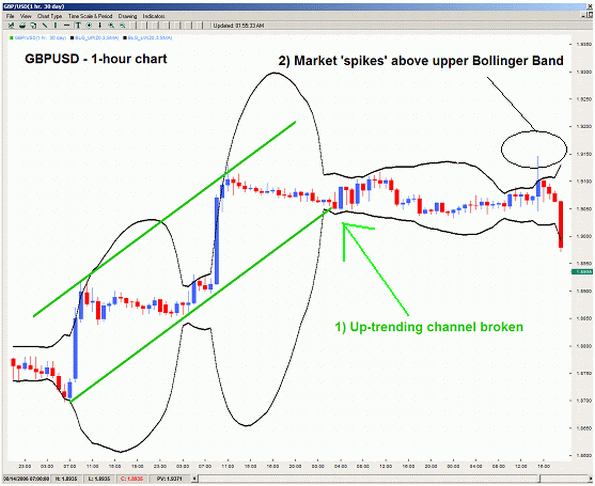Change Of Direction And Exhaustion Spikes
We constantly face the question, what
ingredients make up a good trade? Entry; the
closer that we buy off the bottoms, and sell off
the tops, the greater amount of profit we can
enjoy, while taking on a smaller amount of risk.
Assuming the market establishes a 100-pip
trading range between 1.2100 and 1.2200, it
clearly makes sense that buying at 1.2110 is a
better trade than buying at 1.2150, or 1.2170.
However the dilemma we face is as follows: If we
continue to buy market bottoms, we run the risk
of buying a seemingly never ending downtrend, a
practice also known as 'catching a falling
knife'. So the $10,000 (demo dollar) question
remains how can we buy the bottoms and sell the
tops, only when the trend is in the midst of a
change in direction? The following chart may
help add some light to this predicament.
The following (1-hour) chart shows the GBPUSD
breakdown, below it's established up trending
channel. We may interpret this as a sign of a
change in trend, as the market now shows a
greater likelihood to now reverse back to the
downside. With this in mind, it clearly makes
sense that as we should only look to sell-short
as a broken up-trending channel tells us we have
a better chance to see lower prices in our near
future.
As a general rule of thumb, while buyers try
to go long at the lowest possible price, those
who wish to sell-short should look to do so at
the highest possible level. We can see that
after the up-trending trading channel failed to
contain the market's price action, a
long-candlestick wick popped up above the upper
Bollinger Band. In this application, I prefer to
set the Bollinger Bands to a 3rd standard
deviation as this will help isolate only the
extreme market spikes.
To summarize, our goal is to enter the market
as it takes its last exhausted attempt at a
failing trend. Putting this together, this trade
set-up allows us to identify short-term changes
in trend, and then enter the market at its
relatively extreme price levels. Although this
scenario may not 'play-out' as cleanly every
single time, it provides us with the criteria to
wait for the right trade, and wait for the right
price. Best of luck in trading!!!

|